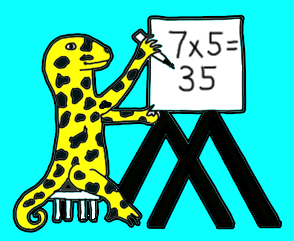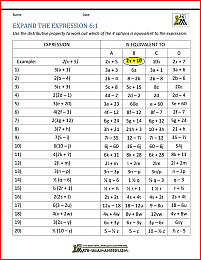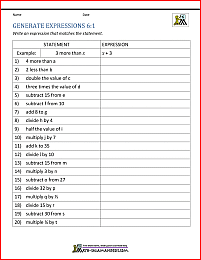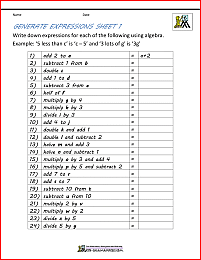- Home |
- About |
- Contact Us |
- Privacy |
- Newsletter |
- Shop |
- Donate
Writing Inequalities from Word Problems

Learn about writing inequalities from word problems with help from our practice examples.
If you want to test yourself, or get some practice, then try one of our graded worksheets, or our online quiz.
Writing Inequalities from Word Problems
Quicklinks to ...
What is an Inequality?
An inequality is when you have a relationship between two values of expressions which are not equal to each other.
There are a few different options for different types of inequalities:
| > | Greater than |
| < | Less than |
| ≥ | Greater than or equal to |
| ≤ | Less than or equal to |
| ≠ | Not equal to |
- Greater than (>) where one expression or value is greater than another, e.g. 7 > 5
- Less than (<) where one expression or value is less than another, e.g. 9 < 2 x 6
- Greater than or equal to (≥) where one expression or value is greater than or equal to another, e.g. 20 + 4 ≥ 17
- Less than or equal to (≤) where one expression or value is less than or equal to another, e.g. 18 ≤ 9 x 2
- Not equal to (≠) where one expression or value is not equal to another, e.g. 7 ≠ 4
The Language of Inequalities
When writing inequalities from word problems, we have to look carefully at and understand the language being used.
Different words and phrases have different meanings when deciding on which inequality to use.
The mathematical notation is really just a shorthand way of writing the words more efficiently and clearly.
Here is a quick table showing some of the written expressions often used and which inequality they are represented by.
| > | < |
|---|---|
| greater than | less than |
| more than | smaller than |
| over | under |
| above | below |
| ≥ | ≤ |
| greater than or equal to | less than or equal to |
| a minimum of | a maximum of |
| at least | at most |
| > and < |
|---|
| strictly between |
| between ... and ... (exclusive) |
| ≥ and ≤ |
| between ... and ... |
| between ... and ... (inclusive) |
| from ... to ... |
Note: the word 'between' is mainly used to mean between inclusively (including end points).
However, sometimes 'between' is used to mean between exclusively (excluding end points).
To avoid ambiguity, it is good practice to include the word 'inclusive' or 'exclusive' to make it completely clear if the end points are included or not.
Some simple examples showing inequalities from phrases:
| Expression in words; | Variable | Inequality |
|---|---|---|
| A maximum of 5 minutes | t | t ≤ 5 minutes |
| More than $100 | m | m > $100 |
| A minimum of 50mph | s | s ≥ 50 mph |
| Less than 12 ounces | w | w < 12 oz |
| Over 20 seconds | t | t > 20 seconds |
| At least 50 points | p | p ≥ 50 points |
| Not equal to three | x | x ≠ 3 |
| Between 5 and 12 (inclusive) | y |
y ≥ 5 and y ≤ 12 or 5 ≤ y ≤ 12 |
| Between 5 and 12 (exclusive) | z |
z > 5 and z < 12 or 5 < z < 12 |
The variable names (letters) have been chosen at random - you can use any variable name to represent any value.
Note: you need to read the word problem carefully because sometimes the inequality does not match the language used, especially when the inequality involves finding out what is left over or what remains after an amount is taken away. See Examples 2) and 7) below.
How to Write Inequalities from Word Problems
When we are writing an inequality from a word problem, we are basically translating the word problem into mathematical language and symbols.
When writing an inequality from a word problem, there are two simple steps you need to follow...
Step 1) Read the word problem carefully and change the word problem into algebra.
- use the language of inequalities table to help you select the right inequality
Step 2) Use algebra to solve the word problem
Step 3) Rewrite the inequality using algebra.
Write an Inequality from a Word Problem Examples
The best way to learn how to write inequalities from word problems and see how they work is to look at some ready made examples.
Writing Inequalities from Word Problems - Basic Examples
Here are some examples of writing inequalities from word problems.
Example 1) Sally bakes some cookies and needs to put them in the over for at least 12 minutes. Write an inequality using the variable t to show how long the cookies need to be baked in the oven.

The vocabulary which tells us about the inequality are the words: at least.
This means we need to use the ≥ symbol.
So the inequality is t ≥ 12 minutes
Example 2) Newton has a 30 ounce bottle of water. He drinks over half of the bottle. Write an inequality using the variable c to show how many ounces are left in the bottle.

The vocabulary which tells us about the inequality are the words: over.
However, because he has drunk over half the bottle, it means that there is under half a bottle left.
So the symbol we need is < and the amount is ½ of 30 = 15.
So the inequality is b < 15 ounces
Example 3) Anna is more than three times as old as Bertie. If Bertie is 8 years old, write an inequality using the variable A to show how old Anna is.
The vocabulary which tells us about the inequality are the words: more than.
So the symbol we need is > and the amount is 3 x 8 = 24.
So the inequality is A > 24 years old
Example 4) A book has 14 chapters.The shortest chapter has 12 pages. Write an inequality using the variable p to show how many pages the book has.

The vocabulary which tells us about the inequality are the words: shortest.
If the shortest chapter has 11 pages, then there must be some chapters with more than 11 pages.
So the symbol we need is > and the amount is 14 x 12 = 168.
So the inequality is p > 168 pages.
Writing Inequalities from Word Problems -Intermediate Examples
These examples use two different variables and express one variable in terms of another.
Example 5) Captain and Frazer have some gold coins. Captain has at least three times as many coins as Frazer. Write an inequality for the number of coins Captain has (c) in terms of the number of coins Frazer has (f).

The vocabulary which tells us about the inequality are the words: at least.
So the symbol we need is ≥
So the inequality is c ≥ 3f.
Example 6) In a hotel there are f flights of stairs. Each flight has a maximum of 12 steps. There are also 3 steps up to the main entrance. Write an expression for the total number of steps, s, in terms of f.

The vocabulary which tells us about the inequality are the words: a maximum of.
So the symbol we need is ≤
We know that there are f flights of steps and also 3 extra steps.
So the inequality is s ≤ 12f + 3.
Writing Inequalities from Word Problems - Harder Examples
These examples involve solving word problems leading to inequalities of the form px + q > r or px + q < r, where p, q, and r are specific rational numbers.
There are also examples where the variable lies between two values.
Example 7) Captain has a one-liter bottle of water. He drinks more than one-quarter of the bottle but less than one-half of the bottle. Write an inequality using the variable b to show the amount of water than is left in the bottle.
The vocabulary which tells us about the inequality are the words: more than and less than.
However, because we are looking at what is left in the bottle, rather than what has been drunk, we need to think carefully about the inequalities!
He drinks more than one-quarter of the bottle, so there will be less than three-quarters of the bottle left, so we need the symbol <
He drinks less than one-half of the bottle, so there will be one-half or more of the bottle left, so we need the symbol ≥
Half of the bottle = ½ liters = 500 ml. 1000 - 500 = 500 ml
Quarter of the bottle = ¼ liters = 250 ml. 1000 - 250 = 750 ml
So the inequality is b ≥ 500 ml and b < 750 ml
This can be simplified to: 500 ≤ b < 750 ml
This means that he has at least 500 ml but less than 750 ml left.
Example 8) Captain has challenged himself to catch a minimum of 50 fish from a lake. He manages to catch 8 of them and put them in his bucket. If he catches 6 fish every hour, write an inequality to show the time (t) in hours it will take him to reach his target.

The vocabulary which tells us about the inequality are the words: a minimum of.
So the symbol we need is ≥
The inequality we get from this problem is 6t + 8 ≥ 50
We are not finished yet, because this needs to be simplified and written in terms of t.
6t + 8 ≥ 50 so 6t ≥ 42
If we divide both sides of this inequality by 6, we get:
t ≥ 7
So the inequality is t ≥ 7 hours
He needs to fish for at least 7 hours to reach his target.
Example 9) It takes Newton between 23 and 28 seconds (inclusive) to swim a length of a swimming pool. Write an inequality using the variable t to show how long it will take him to swim 3 lengths.
The vocabulary which tells us about the inequality are the words: between (inclusive).
So the symbol we need is ≤ and ≥
3 x 23 = 69 and 3 x 28 = 84
So the inequality is t ≥ 69 and t ≤ 84
This can be simplified to: 69 ≤ t ≤ 84
It will take him between 69 and 84 seconds (inclusive) to swim 3 lengths.
Writing Inequalities from Word Problems Worksheets
We have a range of different inequality worksheets which involve writing inequalities from a range of word problems..
We have split the sheets into 3 sections: A, B and C
- Section A involves basic level questions aimed at 6th grade
- Section B involves medium level questions aimed at 6th and 7th grade
- Section C involves more advanced questions aimed at 7th and 8th grade
Writing Inequalities from Word Problems - Section A Easier
Sheet 1 involves picking the vocabulary and relevant information from the problem and writing the inequality
Sheet 2 involves the same skills as Sheet 1, but also involves an arithmetic operation to get the inequality.
Writing Inequalities from Word Problems - Section B Medium
Sheet 1 involves using two variables and writing an inequality for one variable in terms of the other variable
Sheet 2 is similar to Sheet 1 but with slightly harder problems.
Writing Inequalities from Word Problems - Section C
Sheet 1 involves using one variables and using the information to solve the inequality, usually in the form px + q > r or px + q < r, where p, q, and r are specific rational numbers
Sheet 2 involves the same skills as Sheet 1 but has compound inequalities in each question
More Recommended Math Worksheets
Take a look at some more of our worksheets similar to these.
Inequalities on a Number Line Worksheets
6th Grade Ratio and Unit Rate Worksheets
These 5th grade ratio worksheets are a great way to introduce this concept.
We have a range of part to part ratio worksheets and slightly harder problem solving worksheets.
6th Grade Algebra Worksheets
If you are looking for some 6th grade algebra worksheets to use with your child to help them understand simple equations then try our selection of basic algebra worksheets.
There are a range of 6th grade math worksheets covering the following concepts:
- Generate the algebra - and write your own algebraic expressions;
- Calculate the algebra - work out the value of different expressions;
- Solve the algebra - find the value of the term in the equation.
- Use the distributive property to factorize and expand different expressions
Writing Inequalities from Word Problems Quiz
Our quizzes have been created using Google Forms.
At the end of the quiz, you will get the chance to see your results by clicking 'See Score'.
This will take you to a new webpage where your results will be shown. You can print a copy of your results from this page, either as a pdf or as a paper copy.
For incorrect responses, we have added some helpful learning points to explain which answer was correct and why.
We do not collect any personal data from our quizzes, except in the 'First Name' and 'Group/Class' fields which are both optional and only used for teachers to identify students within their educational setting.
We also collect the results from the quizzes which we use to help us to develop our resources and give us insight into future resources to create.
For more information on the information we collect, please take a look at our Privacy Policy
We would be grateful for any feedback on our quizzes, please let us know using our Contact Us link, or use the Facebook Comments form at the bottom of the page.
This quick quiz tests your skill at writing inequalities from a range of word problems.
How to Print or Save these sheets 🖶
Need help with printing or saving?
Follow these 3 steps to get your worksheets printed perfectly!
How to Print or Save these sheets 🖶
Need help with printing or saving?
Follow these 3 steps to get your worksheets printed perfectly!
Subscribe to Math Salamanders News
Sign up for our newsletter and get free math support delivered to your inbox each month. Free seasonal math grab pack included.
Math-Salamanders.com

The Math Salamanders hope you enjoy using these free printable Math worksheets and all our other Math games and resources.
We welcome any comments about our site or worksheets on the Facebook comments box at the bottom of every page.















New! Comments
Have your say about the Math resources on this page! Leave me a comment in the box below.